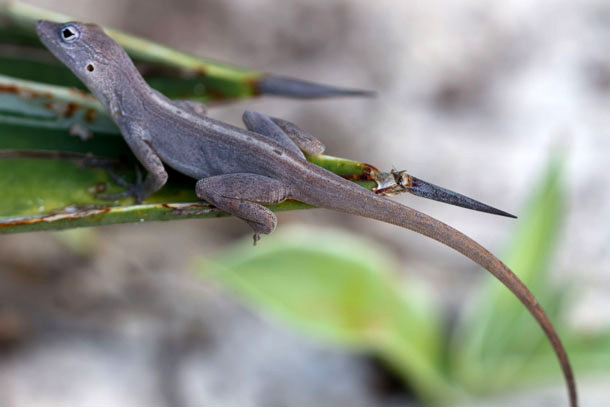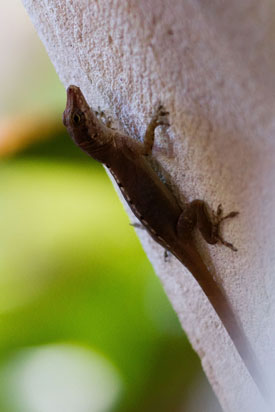Science Note: Hurricanes, Lizards and Leafblowers
Air Date: Week of September 21, 2018

A female anolis scriptus lizard. (Photo: Rian Castillo, Wikimedia Commons CC BY 2.0)
Hurricanes may act as a force of natural selection for Caribbean lizards, according to a recent study in the journal Nature. Living on Earth’s Don Lyman explains how scientists used leaf blowers to simulate hurricane-force winds to study how the hardiest lizards hang on.
Transcript
BASCOMB: Later in the show, the me too movement in climate change research but first this note on emerging science from Don Lyman.
[MUSIC: SCIENCE NOTE THEME]
LYMAN: A recent study published in the journal Nature, demonstrated that hurricanes might act as a force in natural selection for certain lizards. Scientists were already studying a species of anole, Anolis scriptus, a small lizard native to the Turks and Caicos, when Hurricane Irma hit their study area in 2017. The scientists returned to their research site after the storm, and observed that the surviving lizards had longer forelimbs, shorter hindlimbs and bigger toe pads on average, than the overall population of lizards present before the hurricane.
The researchers speculated that perhaps these body characteristics might have helped the remaining lizards survive the hurricane, meaning hurricanes could be a factor in natural selection, possibly affecting the evolutionary trajectory of the lizards. But the scientists also wanted to know how the lizards survived the hurricane to begin with. Did they hide on the ground, or in crevices in trees, or did they ride the storm out by clinging to branches and tree trunks?

A male Anolis scriptus lizard hangs on. (Photo: Rian Castillo, Wikimedia Commons CC BY 2.0)
To find out they took lizards back to the lab, where they perched them on small wooden poles, then simulated hurricane force winds with a leaf blower, gradually ratcheting up the velocity. The researchers found that the lizards stayed on the perch, as opposed to fleeing, and moved to the lee of the perch – the side away from where the wind was blowing. As wind speeds increased, the lizards lost hold with their hindlimbs first, and hung on by their forelimbs until the wind was strong enough to blow them off their perches, unharmed, into a safety net.
If the lizards chose to hide from the wind there would be no reason to think longer or shorter limbs would have anything to do with their survival. But because the lizards chose to ride out the storm on their perch, longer forelimbs could be advantageous.
Scientists caution that there may be other explanations for the body characteristics of the surviving lizards, but hurricane-induced natural selection, or in this case a leaf blower, seems like the best explanation. That’s this week’s note on emerging science. I’m Don Lyman.
Links
The paper in Nature: “Hurricane-induced selection on the morphology of an island lizard”
Living on Earth wants to hear from you!
Living on Earth
62 Calef Highway, Suite 212
Lee, NH 03861
Telephone: 617-287-4121
E-mail: comments@loe.org
Newsletter [Click here]
Donate to Living on Earth!
Living on Earth is an independent media program and relies entirely on contributions from listeners and institutions supporting public service. Please donate now to preserve an independent environmental voice.
NewsletterLiving on Earth offers a weekly delivery of the show's rundown to your mailbox. Sign up for our newsletter today!
 Sailors For The Sea: Be the change you want to sea.
Sailors For The Sea: Be the change you want to sea.
 The Grantham Foundation for the Protection of the Environment: Committed to protecting and improving the health of the global environment.
The Grantham Foundation for the Protection of the Environment: Committed to protecting and improving the health of the global environment.
 Contribute to Living on Earth and receive, as our gift to you, an archival print of one of Mark Seth Lender's extraordinary wildlife photographs. Follow the link to see Mark's current collection of photographs.
Contribute to Living on Earth and receive, as our gift to you, an archival print of one of Mark Seth Lender's extraordinary wildlife photographs. Follow the link to see Mark's current collection of photographs.
 Buy a signed copy of Mark Seth Lender's book Smeagull the Seagull & support Living on Earth
Buy a signed copy of Mark Seth Lender's book Smeagull the Seagull & support Living on Earth

